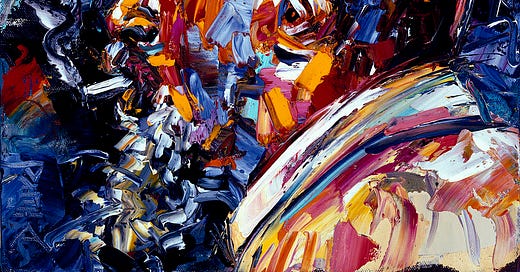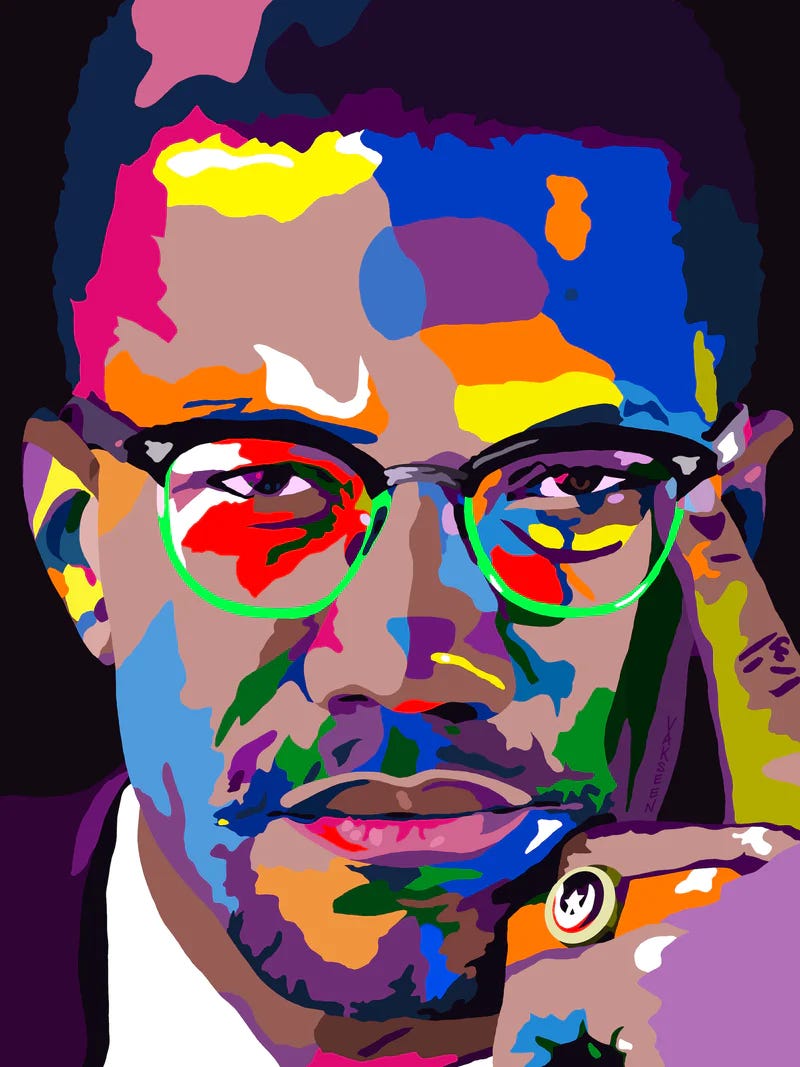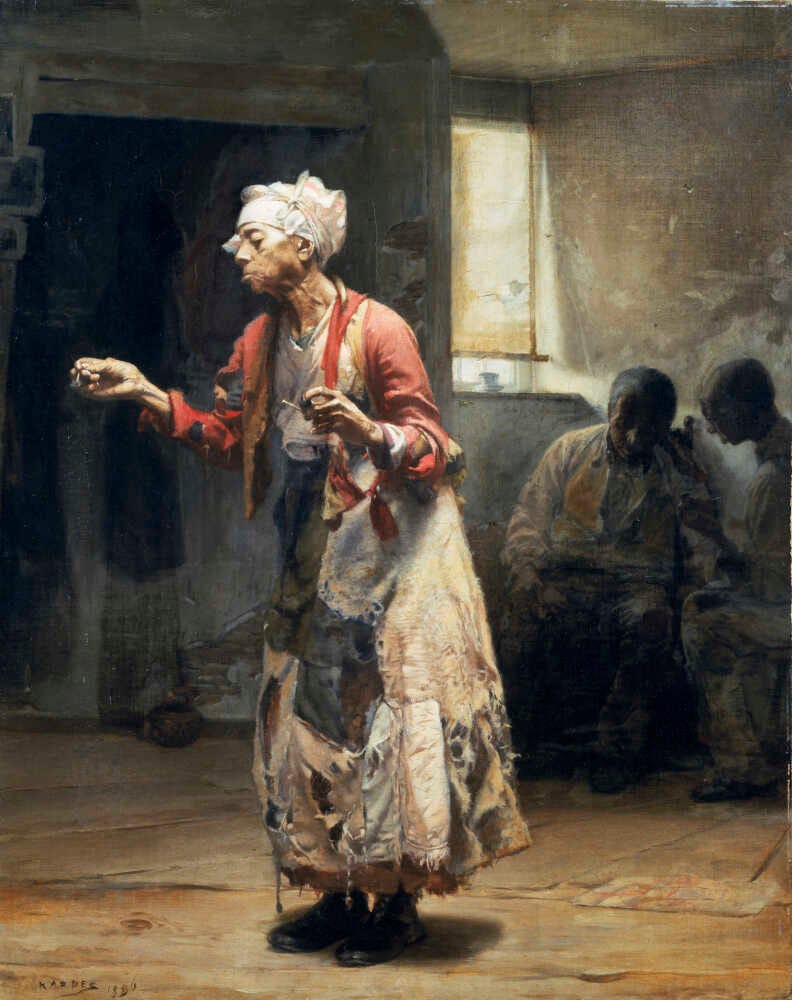Gravity's Rainbow - Part 1 - Chapter 10: A Musical Revelation
Analysis of Gravity's Rainbow, Part 1 - Chapter 10: The Kenosha Kid, Slothrop at the Roseland Ballroom, Down the Toilet
Jazz holds unplayed notes, rhythms that move distinctly, and melodies that often feel incomplete because something is missing, though that something always returns in whatever form — whether it is later in the same piece, in another rendition by the same musician, or by a cover sometime down the road. Or often, these notes, or blank spaces between, hold that meaning over one’s head that can be filled in with whatsoever one chooses. They move along, the pace increases, a staccato hits where you least expect, and then a flair — some pinched high-note out of a trumpet — brings you back, letting you know that yes, this is exactly how it should be. This, in turn, is exactly how Tyrone Slothrop thinks, and how language works.
The Kenosha Kid is language’s derivative of jazz (or, jazz is music’s derivative of language). The same phrase can be turned over, meanings entirely changed — from a signature to a dialogue to an exclamation to a fragment within a sentence. They vary in power, humor, and importance based on anything from punctuation to the surrounding vocabulary; it is just like jazz, where these missing notes or minor variations can rework the piece entirely, though the language stays the same.
Turns out that Slothrop is going over these variations through a drug induced stupor (not one of his own doing) of a "10% Sodium Amytal [dilution], one cc at a time, as needed" (61). While being dosed by PISCES (seems like Pointsman, or someone at The White Visitation, has finally got their hands on what they’ve wanted) he is questioned on what else but his experience in race relations — I mean, he is America, right? so what else is there to question him about. But he is us as well, the (hopefully) socially conscious American. He has those unfortunate tendencies built into his subconscious which allow his mind to flow toward stereotypes and early-twentieth-century minstrel-show dialect. But he knows it’s wrong; he knows they are simply trying to draw out the worst in him. He pleads, "Come one you guys . . . don’t make it too . . ." (62).
The scene switches to memory — sometime back in his past: The Roseland Ballroom, New York City. Slothrop, white as can be, walks through the jazz hall, noticing black bartenders, black musicians, black shoe shiners, all serving and playing music to “White college boys, hollering requests” (62). The college boys call out to the musicians for requests, insisting they play what they want to hear, a clear theme being set immediately as Slothrop walk upstairs into the restroom to vomit up his meal and miscellanea. And with it goes down his harp — his harmonica and sole tool of artistic expression; the low-brow instrument to the high-brow tools of jazz, soon to be historically exploited and pillaged for music more digestible by people with taste just down the hall. And so what is there to do for Slothrop but dive in after the only tool he has, no matter how tacky of one (how hilarious of one even) it may be.
Before he makes any decision to dive, we switch over to Red — Malcolm X before he took on that name — listening as the band begins playing Cherokee, a song covered and improvised by numerous black American jazz musicians, now only to have the “pale Harvard boys and their dates” dance on. Dance to what though, because they seem to miss the point. This isn’t simple music that you two-step to or lose yourself in a simple rhythm and melody, it is more than that — it is “getting […] into some, oh really weird shit . . . .” (64) as we hear staccatos coming at rapid speed mimicking the sounds of bullets and death, long held high notes that pierce your mind, creating a sound which make your face squeeze together to hold back every emotion that single held notes can extract. It is finding every possibility in a song already known, deviating off the beaten path into the subconscious mind of the player — they who have experienced the pains that allow these notes to flow bleeding out of the end of brass. And the Harvard boys dance on, unaware, to mere rhythm.
Slothrop (though we know through his previous pleas that he does not want this to be a part of him, but, given all that he represents, we know it must be apart of him) has an imbedded racism that he is about to explore — all the shit (the literal and metaphorical shit, that is) which makes up America and its conscious and subconscious bigotries. And who to egg him onto these self-discoveries and reckonings but Malcolm X himself (as in reality of course, Malcolm X really did force America to reckon with its inherent bigotries, though, we know how that ended for him when They believed his methods may be a little too effective). Slothrop dips down into the pipes, further into the toilet, admitting he always has known his personal shit has been there, and even begins to recognize specific pieces — that of the Harvard fellows, his friends, Jack Kennedy. And what Slothrop realizes (maybe if, to us, Slothrop were for a moment holding a mask of Pynchon himself over his face) is that if he does find the harp, his method of artistic expression, after this journey of self-exploration, it might just be easier to play.
As a flood comes down upon him, he realizes he has “Nowhere to run” (66). It washes over him, leading to a form of realization and clarity: “At some point the brown dusk around him has begun to lighten” and he sees “People he knows. Inside shells of old, what seem to be fine-packed masonry ruins — weathered cell after cell, many of them roofless” (66). He is witnessing the poor and destitute in their shelter from the dying world that they are a part of and know that “something else has been terribly at this country” (67). He knows it is dying as shit now clings to his skin, his hair, his nostrils.
Pynchon’s solipsism comes out in the guise of Crutchfield — another figure placing the whole of a society on themself: the only Westward man, the only president and assassin — a character to represent them all. Pynchon here1 is admitting that his representation of Slothrop as “America” while simultaneously using Slothrop as a stand-in for himself (or any character to represent anything) is a solipsistic act of creation. It is reductive and will never wholly represent all that America (or again, anything) has to show for itself. But “Half an Ark’s better than none” (68). So in this case, Crutchfield comes out as the old school Westward man — the destroyer and colonizer, slaughtering whatever may be in his wake, holding onto true conscious bigotry, that of a far higher order than Slothrop’s. And his partner, Whappo, always comes hand-in-hand with Crutchfield’s colonization and Westward expansion, for Whappo is greed itself, the capitalist system brought up in the wake of destruction. He wears “chaps of imported gazelle hide that Crutchfield bough for him in Eagle Pass […] a shiny opera hat of Japanese silk” (70) as he and Crutchfield trample the natural and traditional lands of those who lived there before either of them ever stepped foot. Solipsism of course, to put all this on two individuals, but accurate nonetheless.
Slothrop returns, having witnessed this all this shit — though this time having taken the form of two literal people. He sees that there was only one of each who had represented the necessary forces — the characters of the story. He returns for one final connection. A realization that all those language games and their reorganizations of patterns and meanings mimicked jazz and its hidden or rapid notes and changing improvisations, which all in turn mimic the individual’s fragmented examination of their own, and their world’s own, past. Perhaps its an argument to look deeper into these complex arts to allow the brain to make connections it never would have before. Maybe listening to jazz that at first may not even seem musical, or reading sentences that many would deem pretentious nonsense, can actually open up our minds to perceive the world in ways we had once also thought to be insane. But here they are now, clear as day — clear as Slothrop making his way out of the flood.
Thanks again for reading. That one was quite the challenge but I hope it helped reveal the connection between all the wild, often-deemed nonsensical stuff within this chapter. I think it’s the perfect chapter to really analyze to show that a lot of what people may say is Pynchon just being crude and comical actually holds insane depth and importance to his themes (though, he is being crude and hilarious as well, no doubt about it). Would love to hear any other interpretations of this chapter if you happen to have some! Especially on Crutchfield and Whappo since my thoughts may be a stretch.
Up Next: Part 1 —Chapter 11
And take this with a grain of salt given this is the hardest part to analyze in this chapter.







Yeah. This is one of the most famous parts of the book, and for good reason. As you point out, it's the pivot for the reader to understand the relationship between Slothrop and America, or Slothrop's relationship to his Americanness.
Following my Deleuzian reading from college, I would resist the formulation Slothrop=America. Slothrop, I think, is *subject* in all the senses of that word: he is subjected to America. America (and the Zone, and capital itself) occupy the conceptual position of the Body without Organs, which can be thought of as the space in which the subject is formed, or the "socius"/social context, within which meaning is attached to words, and also meaning is de-attached, severed from words, "deterritorialized". The subject is formed not by submission but by conflict, disjunction, a ripping away of meaning and of the social supports that exist in a healthier society.
This is the lesson of the "Kenosha Kid" game -- it teaches us that words have only shifting, socially-dependent meanings. I'm going to quote myself here because no one should have to read through my thesis which is a tangled mess. In fact, when I went back to do this, I realized that I fucked up and hadn't posted Part II at all, that it was just a repetition of Part I, so I updated the post with the actual second third of my GR piece: https://thespouter.substack.com/p/a-schizoanalysis-of-gravitys-rainbow
The phrase “you never did the Kenosha Kid” is always presented in the same word order, but its meaning is manipulated. In the first instance, it is a response to a (somewhat paranoid) query from Slothrop: “Did I ever bother you, ever, for anything, in your life?” In this instance, the Kenosha Kid is an identity; there is a person named the Kenosha Kid. So we immediately have a schizophrenic formation of identity layered on top of what will immediately become a schizophrenic linguistic formation; in (2), the “Kenosha” becomes a dance step, and the “kid” becomes a different identity, the smartass youth. (2.1) illustrates that the schizophrenic formation must not always be so starkly opposed to itself; a subtle shift serves to attach a previous meaning to a new signifier—the dance that was once the “Kenosha” is now the “Kenosha Kid.” This is an important illustration that under a schizophrenic regime of signs, the confusion flows both ways; a single meaning can attach to multiple signs, just as multiple signs can refer to the same meaning. In (3), the “Kenosha Kid” is given another identity, a despot at the center of the Slothrop Affair, a figure of the “They” of Slothrop’s paranoia. In my reading, the Kenosha Kid retains this despotic character in (4), where he becomes the omnipotent despot at the center of a regime of signs; “he gave us in fiery letters across the sky all the words we’d ever need, words we today enjoy, fill our dictionaries with…” This is the origin of the sign as an arbitrary set of signifiers given to us by a despot under whose regime Slothrop rebels by questioning: “you never did ‘the,’ Kenosha Kid!” meaning that the Kenosha Kid forgot to impose his own significance upon that most common and fundamental word, ‘the.’ It is also in (4) that the text becomes self-aware, and gives the reader the setting in which the rest of the episode is to be told. Slothrop is undergoing drugged interrogation at the hand of PISCES, which is one of the organizations in Slothrop’s paranoiac plot. This frame story illustrates Deleuze and Guattari’s description of schizophrenia as “either/or…or…or,” multiple identities. Slothrop is either in the ‘reality’ of being interrogated by PISCES, or he is dancing (2), or he is an employee (3), etc. With initial awareness, Slothrop begins the process of struggling to awaken: “snap to, Slothrop.” But not before lapsing back into his schizophrenic linguistic delusions in (5). There follows one of the most humorous and memorable episodes in the novel: Slothrop narrates to his interrogators at PISCES the story of his journey down the toilet and into an alternate reality in pursuit of his lost harmonica. I will address this episode at more length later. At the end of this episode, Slothrop returns to the Kenosha Kid, for a seventh variation on the phrase:
In the shadows, black and white holding in a panda-pattern across his face, each of the regions a growth or mass of scar tissue, waits the connection he’s traveled all this way to see. The face is as weak as a house-dog’s, and its owner shrugs a lot.
Slothrop: Where is he? Why didn’t he show? Who are you?
Voice: The Kid got busted. And you know me, Slothrop. Remember? I’m Never.
Slothrop(peering): You, Never? (A pause.) Did the Kenosha Kid? (71)
Here again we see another schizophrenic identity of the Kenosha Kid. But this passage also gives another illustration of the ease and wit with which Pynchon employs schizophrenic language: the “connection” is not only a drug dealer, but also a textual connection, back to the beginning of the episode. This pun is one example of how intensely Pynchon interweaves textual self-reflection into the story—the story constantly refers back to itself. This self-referentiality gives the novel another vital component in its schizophrenic nature: along with all the other identities that the text signifies, it also signifies itself. Or, rather, because Slothrop has been seeking out the signifier “The Kenosha Kid”—a textual connection to the beginning of the episode—the text has only ever signified a search for itself.
This enlightening analysis made me think of McCarthy's Thalidomide Kid in "The Passenger". I cannot unsee how McCarthy is deliberately drawing a strong deep underground connection with the Kenosha Kid. A manifestation of the unconscious and language.